 They can be found in the sewer!
They can be found in the sewer!
Most of us don’t spend even a minute of our day contemplating what lies beneath the ground in the sewers. And when we do, the words dark, dirty, smelly, and scary probably come to mind. Encountering what is in a city’s sewer infrastructure is an everyday occurrence for Brad Robertson, a field services manager.
To learn more, we sat down with Brad to talk about his experiences when inspecting sewers. Here are some of the items he has found throughout the years and useful tips and precautions for venturing below the surface.
Wessler: Do you find many strange items in the sewer and what do you do with them?
Brad: Yes, I’m amazed at what we find that shouldn’t be there. What we do with them depends on the value and nature of the items. The toys, traffic cone, clothes, dentures, tree limbs, bicycle, and eating utensils are disposed of. Money is usually kept and divided amongst the crew. Live animals such as mice, rats, snakes, fish, foxes, frogs, turtles, and birds usually flee on their own. I once found a puppy, which I took to a local shelter for adoption. Jewelry such as rings, watches, and necklaces are taken to a pawn shop. Of course, wallets, knives, and pistols are turned over to the police.
Wessler: How does this stuff get in the sewer?
Brad: There are several ways these items end up in the sewer. They are flushed down the toilet; put down cleanout caps, which are located a few feet from owner’s home; or dropped through the openings in manhole lids.
Many of the large diameter sewers we inspect are combination sewers which collect stormwater also. So as the water flows into the sewer during flooding, larger items such as pop bottles and small animals get caught in the current and end up in the sewer.
Wessler: What steps can communities take to prevent so much going into the sewer?
Brad: Taking precautions such as using bolt down lids and snug cleanout caps; keeping streets clean to avoid debris from entering the combination sewer; and contractors barricading new construction sites to avoid vandals from obstructing the sewers.
Wessler: How do you protect yourself against disease and injuries?
Brad: I protect myself by wearing the appropriate gear: chest waders, long-sleeved shirt, hard hat, safety glasses, long rubber gloves, and a gas detector. I make sure my series of Hepatitis shots are current and having a Tetanus shot is also beneficial. Requirements for entering a sewer include fall protection, such as a ladder or tripod and harness, and having the atmosphere tested prior to entering. Having a crew member with radio contact from above at all times is necessary.

Wessler: How can a homeowner avoid sewage backup in their home?
Brad: Although it can be difficult to keep young children from flushing their toys, many homeowners are installing backflow preventers (check valves) to avoid sewer backups into their homes. This is a good idea if the owner has experienced a backup. However, if an item such as a toy car is flushed down the sewer, beware it could catch on the check valve causing the flap gate to remain open and sewage to back up.
The next time you see debris in the street or catch your child flushing something down your home toilet, think of the implications it might have on your home and the community’s sewer system. Not everything can go to the local wastewater treatment plant, so it’s important to keep toys, trash, jewelry, etc. out of the sewer system.
Tags


